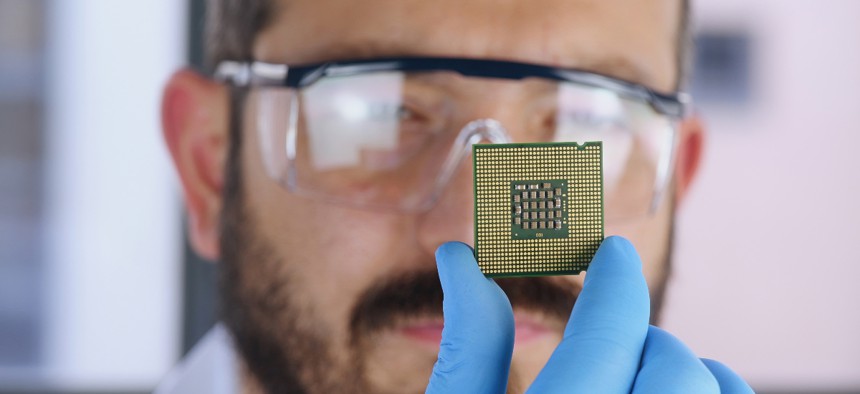Talent and chip production go hand-in-hand

sefa ozel/Getty Images
A group of leaders from government, industry and academia explain how the U.S. needs to solve the workforce challenge in order to meet its semiconductor needs and innovate.
To keep up with the U.S.’s manufacturing goals set out in the CHIPs for America and CHIPS and Science Acts, the U.S. must invest in its workforce, according to panelists that spoke during a summit hosted by Purdue University on Tuesday.
“The thing that worries us the most is workforce development,” Thomas Sonderman, president and CEO of SkyWater, said.
Government, industry and academia officials on the panel noted the importance of the workforce to not only build the necessary manufacturing capabilities, but also to perform research and development. The different sectors agreed that all must work together to address this challenge.
“Public-private partnership is critically important to really heal your workforce of the future. And that's a very big long term vision,” Keyvan Esfarjani, chief global operations officer of Intel, said.
For example, the Commerce Department’s workforce programs are focusing on industry outcomes, according to Eric Lin, interim director of research and development for CHIPS for America at the Department of Commerce.
Meanwhile, Erwin Gianchandani, assistant director of the Directorate for Technology, Innovation and Partnerships at the National Science Foundation, noted that CHIPS for America includes $200 million over the next five years to support semiconductor design and manufacturing, education and workforce development. He noted the agency is thinking about the funding holistically in terms of workforce education and development.
“When we think about our investments, it's about trying to be able to leverage the dollars that Congress has appropriated as partnerships,” Gianchandani said, adding that leveraging the funding with industry will help it go further.
He pointed to NSF’s partnerships with Intel and Micron as examples of “bring[ing] together industry expertise with the higher education community to be able to design rigorous and engaging curriculum, instructional material at all levels that is industry aware and industry reliant, as well as be able to ensure that trainees are providing talent and are well positioned for that talent to be in prime position for the jobs of the future on day one.”
He noted that workforce is a multi-sided component of semiconductor advancement that “spans construction, material development, curriculum and also thinking about ways in which we can consider teacher faculty professional development to be able to prepare the teachers and the educators of the future with the latest and greatest technologies and capabilities emerging from our semiconductor R&D efforts.”
Students will also need opportunities to take skills they’ve learned in the classroom into a practical setting.
The panelists emphasized the importance of expanding and scaling the workforce, which could be accomplished in several ways, such as reskilling or upskilling workers and tapping into groups like veterans and women.
“The one program that I’m very passionate about is reskilling veterans,” Ajit Manocha, president and CEO of SEMI, said. “Those are the best workers for getting the most specific technical positions we have in this industry.
Tsu-Jae King Liu, dean and Roy W. Carlson professor of engineering at the University of California Berkeley, added that retired or semi-retired professionals could serve as mentors to guide and inspire the next generation of workers.
According to the panelists, curriculums need to be upgraded so students will be ready to work and not be learning on outdated systems or equipment.
The academic panelists also discussed the importance of hands-on learning and for academic institutions to partner with industry to allow students to have the opportunity to use state-of-the art equipment that is often too expensive for universities to purchase.
“At our [fabrication facility] in Florida, we have a school literally right next door, so we have 10th graders, 11th graders, seniors that are all coming in to journey inside our fab and are actually solving problems, then having a pathway,” Sonderman said.
The panelists also noted the price of education in the U.S. is limiting the number of advanced degrees in the country, particularly for American students, as a good portion of students for advanced degree programs are international.
However, whether for undergraduate or graduate degrees, current immigration laws mean that international students that are educated in the U.S. often must go back to their home country because there is no clear path for them to stay beyond their education. But, the panelists asserted this is an untapped talent opportunity that could help address workforce challenges.
Additionally, the time it takes to get advanced degrees will also limit the workforce pipeline over the next few years.
“We have to realize that for the next 10 years or so the pipeline is more or less fixed,” Mark Lundstrom, Don and Carol Scifres Distinguished professor of engineering and chief semiconductor officer at Purdue University, said. “Enrollments at large flagship public universities are rapidly slowing …what we need to do to move the needle in the next few years is we need to convince more of these students to consider preparing careers in the semiconductor industry and we can move the needle fairly quickly in a three to five year time frame.”
Lundstrom suggested creating a network of universities with programs focusing on semiconductors and related skills and to work with industry to help address workforce needs.
There is also the challenge of attracting the next generation of workers. Philip Wong, Willard R. and Inez Kerr Bell professor of engineering at Stanford University, noted that students and others new entries to the workforce may not be attracted to semiconductors because “we don't recognize the importance of semiconductors.”
According to the panelists, the semiconductor industry needs workers with a variety of skills, from advanced-degree engineers, to technicians, to construction workers that can build the fabrication facilities. They also emphasized that the industry needs to attract workers from a variety of skills and sciences.


